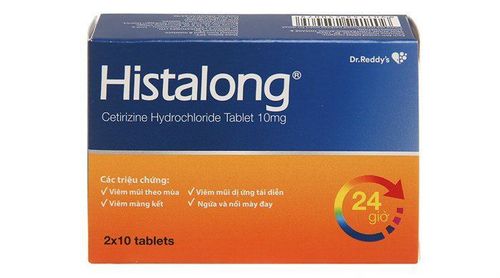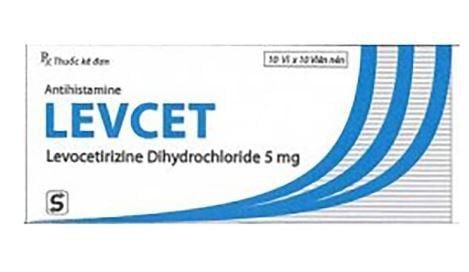This is an automatically translated article.
Betalestin is a prescription drug, indicated in cases of chronic allergic rhinitis, allergic conjunctivitis... To ensure effective use of Betalestin, patients need to follow the instructions of a specialist doctor. faculty, and refer to more information content in the article below.
1. What does Betalestin do?
1.1. What is Betalestine? Betalestin belongs to the group of anti-allergic drugs, with registration number VD-13554-10, manufactured by Mekophar Pharmaceutical Joint Stock Company.
Betalestin drug includes the following ingredients:
Main active ingredients: Betamethasone 0.25mg and Chlorpheniramine maleate 2mg. Excipients: Lactose, corn starch, Pregelatinized starch, Povidone, Magnesium stearate and Erythrosine color. The drug is prepared in the form of blister tablets of 15 tablets, boxes of 2 blisters or boxes of 500 loose tablets.
Betalestin is recommended for use in children from 1 month of age and adults.
1.2. What does Betalestine do? Betamethasone is a substance belonging to the group of glucocorticoids, with strong anti-inflammatory, anti-allergic and anti-arthritic effects. Betamethasone is suitable for the treatment of severe or chronic allergies or when conventional anti-allergic drugs have failed. The active ingredient Chlorpheniramine belongs to the group of antihistamines. With the effect of preventing the body's histamine from attaching to the receptors and reducing the symptoms of allergies such as runny nose, sneezing or hives,...
Betalestin is indicated for the treatment of: Cases:
Allergic rhinitis : Relieves symptoms of nasal itching, sneezing and runny nose... Allergic conjunctivitis, insect sting dermatitis, eczema (atopic dermatitis), pollen allergy flowers and food allergies. The drug is contraindicated in the following cases:
Patients are allergic to the main active ingredients Chlorpheniramine and Betamethasone or any of the excipients of the drug. The patient has been taking or has been taking an MAO inhibitor within the 2 weeks prior to the appointment of Betalestin. Patients with bacterial infections, viral infections, systemic fungal infections. Peptic ulcer and duodenal ulcer, pyloric - duodenal obstruction. Infants less than 1 month old and especially premature babies. Acute asthma attack. Patients with diabetes, psychiatric or narrow angle Glaucoma. The patient has bladder neck obstruction and an enlarged prostate gland.
2. How to use Betalestine?
2.1. How to take Betalestin Betalestin is taken orally. It is best to take the medicine after eating and before going to bed. When the patient has improved clinically or after prolonged use of Betalestin, and wants to discontinue use, it is necessary to gradually reduce the current dose to the minimum clinically effective dose and then gradually stop the drug completely. Do not stop taking Betalestin suddenly when the disease has improved. 2.2. Dosage of Betalestin The dose of Betalestin for each patient is different and can be adjusted according to the severity, course of the disease, and the patient's response to the indicated dose. This should be done by a doctor:
Adults and children over 12 years old: 1 to 2 tablets 1 time. Children from 6 to 12 years old: 1 tablet/time. Children from 2 to 6 years old: 1⁄2 tablets/time. Use 4 to 6 times a day. Handling missed dose: If you miss a dose, take Betalestin as soon as you remember. If it is too late to take your dose and it is almost time for your next dose, skip the missed dose and take the next scheduled dose. Do not take a double dose to make up for a missed dose. Overdose management: Symptoms of prolonged use of Betalestin are similar to those of other corticosteroids including:
Salt retention, water retention, increased appetite. Osteoporosis, hyperglycemia and nitrogen loss. Increased risk of infection and adrenal insufficiency. Mental disorders and muscle weakness. Syndrome of decreased tissue regeneration. If you experience the above symptoms of overdose while using Betalestin, the patient should notify the treating doctor and immediately go to the hospital for examination.
3. Notes when using Betalestine
An important rule to keep in mind when using Betalestin is that at the start of the drug, only the minimum effective dose should be used, and then gradually increase the dose. When preparing to stop using the drug, it is necessary to reduce the dose gradually and then stop completely. Use with caution in the elderly (>60 years), patients with prostatic hypertrophy, myasthenia gravis, taking sedatives, drinking alcohol, people with advanced pulmonary tuberculosis, cardiovascular disease, liver failure, renal failure or osteoporosis Avoid using Betalestin when driving or operating machinery because it causes distraction, drowsiness and drowsiness. Pregnancy - lactation: Using betalestin for pregnant women, those who are breast-feeding or women of childbearing age, it is necessary to weigh the benefits of treatment against the risks of the drug. to the mother herself, to the fetus or to the infant. The patient must absolutely follow the doctor's prescription, do not arbitrarily add or reduce the dose and duration of the drug. Do not use Betalestin when it has expired, the tablet changes color, mold, rot or has a strange smell.
4. Betalestine side effects
At therapeutic doses, Betalestin is well tolerated. However, the process of using Betalestin, patients may still experience side effects such as:
Most common:
Feeling lightheaded, ecstatic, nausea and dizziness.
Uncommon:
Irritability, weakness, dry mouth, anorexia, headache, anxiety, heartburn, double vision, sweating, polyuria, dysuria and dermatitis; Disorders of water and electrolyte imbalance: Hypokalemia, potassium loss, fluid retention, hypertension, congestive heart failure, in susceptible patients. Endocrine and metabolic disorders: Development of Cushing's syndrome, cessation of ACTH secretion, reversible decreased glucose tolerance, atrophy of the adrenal cortex, diabetes mellitus, inhibition of intrauterine and infant growth small, irregular menstrual periods, increased need for insulin or hypoglycemic drugs in people with diabetes. If you experience these symptoms, you need to stop using Betalestin and notify your doctor for appropriate treatment.
5. Betalestine drug interactions
Should not be used together or combined with Betalestin with the following drugs:
Monoamine oxidase inhibitors: Increases the effect and prolongs the duration of action of Chlorpheniramine, which can lead to severe hypotension. Phenytoin, Phenobarbital, Rifampicin, Ephedrine: Increases the metabolism of corticosteroids, leading to a decrease in the therapeutic effect of the drug. Anticoagulants: Betalestin inhibits the anticoagulant effect of drugs in this class. Glycoside digitalis: Corticosteroid drugs increase the risk of arrhythmias, hypokalemia and digitalis toxicity. Non-Steroidal Anti-Inflammatory Drugs: Increases risk and severity of peptic ulcers. Alcohol: Increases the sedative effect of chlorpheniramine and increases the risk of peptic ulcers. Betalestine may cause an increase in blood sugar. Therefore, it may be necessary to adjust the dose of antidiabetic agents in combination. Inform your doctor about all medications you are taking, prescription or nonprescription, dietary supplements, or herbal remedies to limit possible drug interactions.
6. How to store Betalestine?
The shelf life of Betalestin is 24 months from the date of manufacture. Store the drug product at an ideal temperature below 25 degrees Celsius, do not expose the medicine to direct sunlight, high temperature places such as the top of the refrigerator or the top of the TV Avoid storing the medicine in humid places. such as in the bathroom, where the humidity is higher than 70%. Keep medicine out of reach of small children. Above is all information about Betalestin, patients need to carefully read the instructions for use, consult a doctor / pharmacist before use. Note, Betalestin is a prescription drug, patients should absolutely not buy and treat at home because they may experience side effects and dangerous drug interactions.













